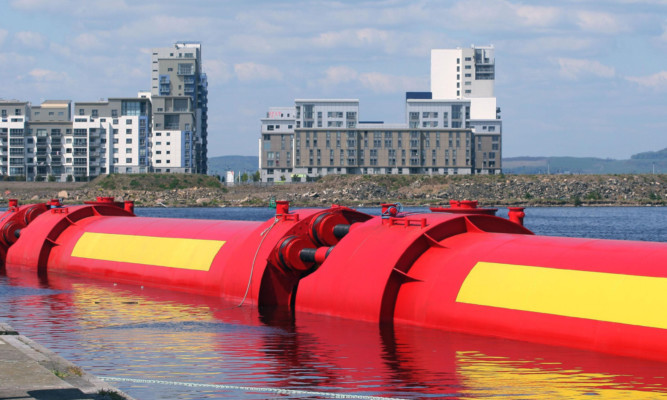
A wave new world?
Surrounded by raging tides it should come as no surprise Britain has been riding the crest of a wave as a marine energy superpower.
An undisputed world leader in the field, former First Minister Alex Salmond went as far as labelling Scotland a future “Saudi Arabia of tidal power”.
But the industry is in perilous waters.
Thanks to investors favouring proven wind turbines over discrete tide-capturing machines and a perception anything offshore is expensive and perilous, the industry is suffering.
On Friday, a major wave farm planned in Shetland was abandoned.
One of the biggest investors in the project, the Swedish company Vattenfall, said the timescale for securing commercial wave power was uncertain and they would focus on wind farms instead.
It’s the latest blow to wave power.
Two marine industry giants have found themselves in deep water in the last year, with a report in December ominously warning the sector is “on the verge of floundering”.
Professor Stephen Salter, an inventor known as ‘the father of wave power’, has warned: “The industry is in danger of going pear-shaped.”
Massive breakthroughs in wave power capturing technology were being made in Scotland as far back as the ’70s.
It had been hoped the industry would be worth £50 billion by 2050.
A positive step was taken in 2004 when the world’s first offshore wave power machine was unveiled at the Port of Leith, Edinburgh.
They were heady times, with predictions the National Grid would be flooded with energy from a truly green power generating giant.
Fast forward 10 years and the firm behind the device, Pelamis, is in administration and in receipt of bail-out cash from the Scottish Government, while no private buyer has yet been found a telling state of affairs.
Another marine energy powerhouse, Aquamarine Power, has also been swept into perilous waters following a large downsizing of its operation.
These companies aren’t small players they are the biggest names in town.
Then at the tail-end of last year, the UK’s flagship technology innovation and research centre for offshore wind, wave and tidal energy, Offshore Renewable Energy Catapult, published a damning report revealing that £300 million was needed to keep the industry afloat.
It’s led to Mr Salter, who is emeritus professor of engineering design at Edinburgh University, fearing for the industry’s future.
He came to prominence in the 1970s when he created Salter’s Ducks, a device to harvest waves into energy.
He said: “It’s very sad what has happened in the last year. Tidal, wave and wind has the capacity to generate 100% of the energy we need in the UK.
“There are some issues, such as where to store this energy, but the pay-backs are massive.
“Marine energy faces sizeable challenges. Private investors want quick returns and are therefore interested in backing wind energy, a more developed industry.
“There is too little money going into marine and too little time.
“The organisations involved should also be sharing more of their knowledge.
“Just now they only want to see their competitors make the same mistakes they have done. It’s not a good method.”
The Scottish Government, which sank close to £40 million into private companies Pelamis and Aquamarine Power, has been accused of not doing enough.
In their defence they say they have set up a body, Wave Energy Scotland (WES), to make sure none of the intellectual property built up is lost.
A spokesman said: “There is no doubt these are highly challenging times for the wave energy industry across the world.
“In Scotland, we have outstanding natural resources, world-class test facilities and engineering and academic expertise which WES will harness to ensure we can achieve our potential in this growing international sector.”
Despite the stormy waters, wave and tidal expert Simon Cheeseman, from (ORE) Catapult, believes the future remains rosy.
He said: “There are real challenges and the last year hasn’t been easy. But that is because this is so very new.
“There is a realisation we can no longer rely on fossil fuels. Wave and tidal has the potential to be a safe, secure energy source.
“What’s more, we are so ahead of everyone else there is the very real prospect of being exporters of energy in the future.”
Lindsay Leask, of Scottish Renewables, said while the end of 2014 may have been a difficult time for the marine energy sector, “It’s all too easy to forget the successes”.
She added: “It’s clear the wave and tidal sectors are still at very different stages in their life cycle. Wave technologies are still very much in the research phase.
“But their potential is enormous and the Scottish Government should be applauded for its continued commitment to the sector.
“We know we can extract energy from the seas, the challenge is now doing it in a way that is commercially viable.”
And there may be new hope on the horizon.
The MeyGen project, to be built in a notoriously stormy section of water known as Hell’s Mouth, off Caithness, will hopefully prove a much-needed boost.
Work started last month on construction of what promises to be the world’s largest tidal energy array in the Pentland Firth, the strait between Orkney and the north tip of Scotland.
Nearly 300 underwater turbines will provide 398MW of green energy enough to power a city the size of Dundee it is hoped.
When 500 delegates due to gather at the 12th annual Renewable UK Wave and Tidal conference in Edinburgh at the end of the month, it’s hoped the Hell’s Mouth fillip will be heaven-sent for an industry in troubled waters.

Enjoy the convenience of having The Sunday Post delivered as a digital ePaper straight to your smartphone, tablet or computer.
Subscribe for only £5.49 a month and enjoy all the benefits of the printed paper as a digital replica.
Subscribe